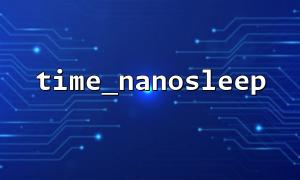In PHP, the time_nanosleep function is used to make the program pause the specified number of seconds and nanoseconds. Compared with traditional sleep functions, it provides higher precision delay control, especially suitable for scenarios with higher time accuracy requirements, such as high frequency polling, timers or delay tasks. This article will take you into the deeper understanding of the underlying implementation mechanism of the time_nanosleep function and help you master its use through sample code.
The prototype of the time_nanosleep function is as follows:
bool time_nanosleep(int $seconds, int $nanoseconds)
$seconds is the number of seconds to pause and must be a non-negative integer.
$nanoseconds is the extra nanoseconds, ranging from 0 to 999,999,999.
Returns true when the function succeeds. If the pause is interrupted, an array containing the remaining time will be returned.
PHP's time_nanosleep is not entirely implemented by PHP itself, but depends on system calls from the underlying operating system. It mainly relies on the nanosleep function in the POSIX standard, which is supported in most Unix-like systems.
The nanosleep function allows the program to suspend execution of specified seconds and nanoseconds, thereby achieving nanosecond-level delay. The underlying principle is as follows:
System calls enter kernel state <br> When PHP calls time_nanosleep , the underlying layer will call the nanosleep function implemented in the C language to issue a suspended request to the operating system.
Kernel scheduling pause <br> After the kernel receives the request, it will suspend the current process for a specified time, and the CPU will switch to other processes to execute, improving resource utilization efficiency.
Recover the process after the time has arrived <br> When the time comes, the kernel will wake up the process and continue to execute PHP code.
Processing signal interrupt <br> If the process receives a signal (such as an interrupt) during the waiting period, nanosleep will return in advance and inform the remaining waiting time.
In Windows systems, due to the lack of nanosleep , PHP calls the equivalent Sleep or SleepEx functions, but the accuracy may not be as high as that of POSIX systems.
PHP's time_nanosleep is actually implemented in C language in its extension module, and the core calls are similar to the following pseudo-code:
PHP_FUNCTION(time_nanosleep)
{
zend_long sec, nsec;
struct timespec req, rem;
if (zend_parse_parameters(ZEND_NUM_ARGS(), "ll", &sec, &nsec) == FAILURE) {
return;
}
if (sec < 0 || nsec < 0 || nsec > 999999999) {
zend_argument_value_error(1, "seconds must be >= 0 and nanoseconds between 0 and 999999999");
RETURN_FALSE;
}
req.tv_sec = sec;
req.tv_nsec = nsec;
if (nanosleep(&req, &rem) == 0) {
RETURN_TRUE;
} else {
array_init(return_value);
add_assoc_long(return_value, "seconds", rem.tv_sec);
add_assoc_long(return_value, "nanoseconds", rem.tv_nsec);
}
}
In this code:
nanosleep is the key system call.
If 0 is successfully returned, PHP returns true .
If the signal is interrupted, the remaining time array is returned.
<?php
echo "Start time:" . microtime(true) . "\n";
// pause 1 Second 500 毫Second
$result = time_nanosleep(1, 500000000);
if ($result === true) {
echo "pause成功\n";
} else {
echo "pause被中断,time left:" . $result['seconds'] . " Second " . $result['nanoseconds'] . " 纳Second\n";
}
echo "End time:" . microtime(true) . "\n";
?>
Run this code and you can see that the program will pause for about 1.5 seconds, reflecting the high-precision pause capability of time_nanosleep .
time_nanosleep cannot guarantee absolute accuracy, and the actual delay may be slightly deviated, which is affected by operating system scheduling.
The maximum value of the nanosecond parameter cannot exceed 999,999,999, otherwise an error will be returned.
On Windows platforms, the accuracy is relatively low and mainly depends on the system timer.
This function is suitable for high-precision timing and short interval control, but is not a replacement for the hard real-time timer of the real-time operating system.
The time_nanosleep function is an interface for PHP to access the operating system's high-precision sleep mechanism, and the underlying layer relies on the POSIX standard nanosleep system calls. It provides developers with seconds and nanoseconds time control capabilities, suitable for application scenarios that require precise delays. By understanding its underlying implementation, it helps to better understand the behavioral characteristics and usage limitations of functions.
To gain insight into the underlying implementation of PHP functions, you can refer to the official PHP source code or the nanosleep documentation of related operating systems, for example:
Through these resources, we can further explore how PHP works closely with the system to achieve efficient time management.














